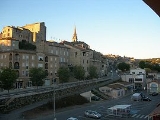
Joyeuse, Ardèche
Encyclopedia
Joyeuse is a commune
in the Ardèche
department in the Rhône-Alpes
region
in southern France
.
, in the valley of the Beaume, a tributary of the Ardèche River
.
Communes of France
The commune is the lowest level of administrative division in the French Republic. French communes are roughly equivalent to incorporated municipalities or villages in the United States or Gemeinden in Germany...
in the Ardèche
Ardèche
Ardèche is a department in south-central France named after the Ardèche River.- History :The area has been inhabited by humans at least since the Upper Paleolithic, as attested by the famous cave paintings at Chauvet Pont d'Arc. The plateau of the Ardeche River has extensive standing stones ,...
department in the Rhône-Alpes
Rhône-Alpes
Rhône-Alpes is one of the 27 regions of France, located on the eastern border of the country, towards the south. The region was named after the Rhône River and the Alps mountain range. Its capital, Lyon, is the second-largest metropolitan area in France after Paris...
region
Régions of France
France is divided into 27 administrative regions , 22 of which are in Metropolitan France, and five of which are overseas. Corsica is a territorial collectivity , but is considered a region in mainstream usage, and is even shown as such on the INSEE website...
in southern France
France
The French Republic , The French Republic , The French Republic , (commonly known as France , is a unitary semi-presidential republic in Western Europe with several overseas territories and islands located on other continents and in the Indian, Pacific, and Atlantic oceans. Metropolitan France...
.
Geography
Joyeuse lies in the historic region of Bas-VivaraisVivarais
Vivarais is a traditional region in the south-east of France, covering the département of Ardèche, named after its capital Viviers on the river Rhône...
, in the valley of the Beaume, a tributary of the Ardèche River
Ardèche River
The Ardèche is a 125 km long river in south-central France, a right-bank tributary of the Rhône River. Its source is in the Massif Central, near the village of Astet. It flows into the Rhône near Pont-Saint-Esprit, north-west of Orange...
.
Population
Personalities
- Marcus Julius Bassus, Roman consul, whose tomb is near Joyeuse
- CharlemagneCharlemagneCharlemagne was King of the Franks from 768 and Emperor of the Romans from 800 to his death in 814. He expanded the Frankish kingdom into an empire that incorporated much of Western and Central Europe. During his reign, he conquered Italy and was crowned by Pope Leo III on 25 December 800...
, founder of Joyeuse according to tradition - Duke Anne de JoyeuseAnne de JoyeuseAnne de Batarnay de Joyeuse, Baron d'Arques, Vicomte then Duke of Joyeuse was a royal favourite and active participant in the French Wars of Religion....
- Cardinal François de JoyeuseFrançois de JoyeuseFrançois de Joyeuse was a French churchman and politician.Born at Carcassonne, François de Joyeuse was the second son of Guillaume de Joyeuse and Marie Eléanor de Batarnay. As the younger son of a seigneur in an intensely religious family of bishops and soldiers, he was destined for a career in...
- Duchess Henriette Catherine de JoyeuseHenriette Catherine de JoyeuseHenriette Catherine de Joyeuse was the daughter of Henri de Joyeuse and Catherine de Nogaret. She married her first husband, Henri de Bourbon, Duke of Montpensier, on 15 May 1597 and her second husband, Charles, Duke of Guise, on 6 January 1611.- Marriages and children :From her first marriage to...
- la Grande Mademoiselle
- François Boissel
- See List of Dukes of Joyeuse
Sights
- The Château de Joyeuse is a classed as a monument historiqueMonument historiqueA monument historique is a National Heritage Site of France. It also refers to a state procedure in France by which national heritage protection is extended to a building or a specific part of a building, a collection of buildings, or gardens, bridges, and other structures, because of their...
. An earlier castle was largely destroyed and rebuilt in the 16th century. Today it serves as the mairie.
- The Oratorian college is a monument historique. It was founded by Duchess Henriette in 1617 with the permission of Pope Paul VPope Paul V-Theology:Paul met with Galileo Galilei in 1616 after Cardinal Bellarmine had, on his orders, warned Galileo not to hold or defend the heliocentric ideas of Copernicus. Whether there was also an order not to teach those ideas in any way has been a matter for controversy...
. It served as an educational institution until the French RevolutionFrench RevolutionThe French Revolution , sometimes distinguished as the 'Great French Revolution' , was a period of radical social and political upheaval in France and Europe. The absolute monarchy that had ruled France for centuries collapsed in three years...
. It is now the home of a museum dealing with the cultivation and use of the sweet chestnutSweet ChestnutCastanea sativa is a species of the flowering plant family Fagaceae, the tree and its edible seeds are referred to by several common names such Sweet Chestnut or Marron. Originally native to southeastern Europe and Asia Minor, it is now widely dispersed throughout Europe and parts of Asia, such as...
, from foodstuffs to furniture.
- The church of Saint Peter, a third monument historique, dates from the eleventh century. The church was reconstructed in the 17th century.
- The hôtel de Montravel was built between the 12th and 14th centuries although the front façade dates from 1775.
- Museums include a museum of local history, the Espace historique et légendaire, and the Maison de la caricature et du dessin d'humour, a museum of caricatureCaricatureA caricature is a portrait that exaggerates or distorts the essence of a person or thing to create an easily identifiable visual likeness. In literature, a caricature is a description of a person using exaggeration of some characteristics and oversimplification of others.Caricatures can be...
.

